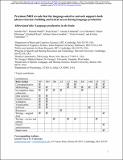| dc.contributor.author | Hu, Jennifer | |
| dc.contributor.author | Small, Hannah | |
| dc.contributor.author | Kean, Hope | |
| dc.contributor.author | Takahashi, Atsushi | |
| dc.contributor.author | Zekelman, Leo | |
| dc.contributor.author | Kleinman, Daniel | |
| dc.contributor.author | Ryan, Elizabeth | |
| dc.contributor.author | Nieto-Castañón, Alfonso | |
| dc.contributor.author | Ferreira, Victor | |
| dc.contributor.author | Fedorenko, Evelina | |
| dc.date.accessioned | 2023-03-27T13:24:04Z | |
| dc.date.available | 2023-03-27T13:24:04Z | |
| dc.date.issued | 2022 | |
| dc.identifier.uri | https://hdl.handle.net/1721.1/148770 | |
| dc.description.abstract | <jats:title>Abstract</jats:title>
<jats:p>A fronto-temporal brain network has long been implicated in language comprehension. However, this network’s role in language production remains debated. In particular, it remains unclear whether all or only some language regions contribute to production, and which aspects of production these regions support. Across 3 functional magnetic resonance imaging experiments that rely on robust individual-subject analyses, we characterize the language network’s response to high-level production demands. We report 3 novel results. First, sentence production, spoken or typed, elicits a strong response throughout the language network. Second, the language network responds to both phrase-structure building and lexical access demands, although the response to phrase-structure building is stronger and more spatially extensive, present in every language region. Finally, contra some proposals, we find no evidence of brain regions—within or outside the language network—that selectively support phrase-structure building in production relative to comprehension. Instead, all language regions respond more strongly during production than comprehension, suggesting that production incurs a greater cost for the language network. Together, these results align with the idea that language comprehension and production draw on the same knowledge representations, which are stored in a distributed manner within the language-selective network and are used to both interpret and generate linguistic utterances.</jats:p> | en_US |
| dc.language.iso | en | |
| dc.publisher | Oxford University Press (OUP) | en_US |
| dc.relation.isversionof | 10.1093/CERCOR/BHAC350 | en_US |
| dc.rights | Creative Commons Attribution-Noncommercial-Share Alike | en_US |
| dc.rights.uri | http://creativecommons.org/licenses/by-nc-sa/4.0/ | en_US |
| dc.source | bioRxiv | en_US |
| dc.title | Precision fMRI reveals that the language-selective network supports both phrase-structure building and lexical access during language production | en_US |
| dc.type | Article | en_US |
| dc.identifier.citation | Hu, Jennifer, Small, Hannah, Kean, Hope, Takahashi, Atsushi, Zekelman, Leo et al. 2022. "Precision fMRI reveals that the language-selective network supports both phrase-structure building and lexical access during language production." Cerebral Cortex. | |
| dc.contributor.department | Massachusetts Institute of Technology. Department of Brain and Cognitive Sciences | en_US |
| dc.relation.journal | Cerebral Cortex | en_US |
| dc.eprint.version | Author's final manuscript | en_US |
| dc.type.uri | http://purl.org/eprint/type/JournalArticle | en_US |
| eprint.status | http://purl.org/eprint/status/PeerReviewed | en_US |
| dc.date.updated | 2023-03-27T13:19:40Z | |
| dspace.orderedauthors | Hu, J; Small, H; Kean, H; Takahashi, A; Zekelman, L; Kleinman, D; Ryan, E; Nieto-Castañón, A; Ferreira, V; Fedorenko, E | en_US |
| dspace.date.submission | 2023-03-27T13:19:44Z | |
| mit.license | OPEN_ACCESS_POLICY | |
| mit.metadata.status | Authority Work and Publication Information Needed | en_US |
